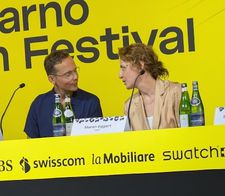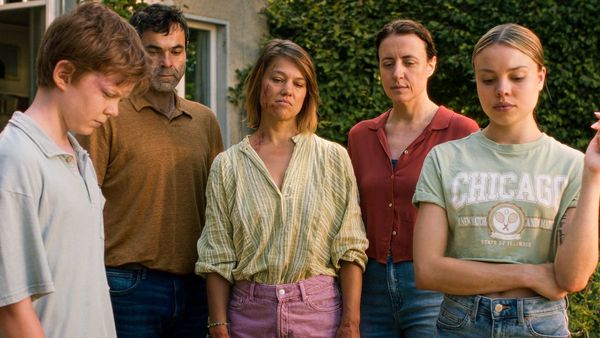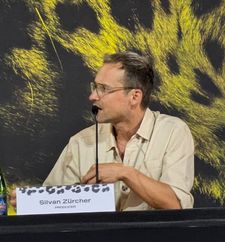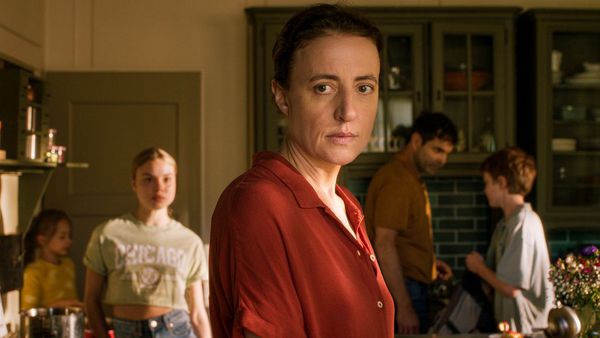 |
| Ramon Zürcher chats to star Maren Eggert Photo: Amber Wilkinson |
“The image of metamorphosis was really central for the film,” says Ramon.
“There’s a first Karen and there’s a second Karen, because after the second day, she kind of changes. It's really a little bit like a caterpillar becoming a butterfly. So metamorphosis is the central thought of the storytelling or of the story design, it’s the fundament of the story. There’s a first existence, then things happen - conflicts, tenderness - then it changes and it becomes a new form. What I like is that metamorphosis is often something which is visual. But there’s also a question of metamorphosis on a psychological level, when it's something invisible and interior which changes and how to make it visible.”
There are plenty of very different physical metamorphoses on display in the film. The butterflies Ramon mentioned do eventually show up, suddenly free to move very differently than before but there’s also a sea squirt which, having eaten its brain as part of its metamorphosis, can no longer move. Meanwhile the trapped sparrow gets a reprieve, while another animal is not so lucky. Ramon says that he thinks creating tensions between these things in his films is an “unconscious” choice.
He continues: “Now, as you describe it, it's very clear. I like how you describe the idea of the sea squirt,, which eats its brain and then becomes like a tree, it’s still. That could be one possibility of living or, the other, is to be like a bird to be free and go everywhere. So, two sketches of living which are actually very important for the film. Also, with the character of Liv, who kind of is free, has no family, could go everywhere but she lives there in the wooden cabin looks on that beautiful house which is like a small summer paradise. She has like a little bit of a desire for that staticness or a desire to be part of that family, to have that closeness and tenderness with the children. She would like to have a baby, so actually, she’s like the sea squirt. She would like to have those roots. And Karen has those roots but wants to be free like the bird. So there are different possibilities which are in conflict. When the possibilities are lived, they don’t really want it, so it’s full of desire.”
 |
| Ramon Zürcher: 'I didn't only want to show the prison but also a liberation - that something changes' Photo: Zürcher Film |
One of the things that heightens watching the film and helps to draw it slightly away from naturalism is the sound design.
Silvan notes that it was Ramon who guided the sound design, adding, “You co-worked with Peter von Siebenthal.”
Ramon says that as he edits the film he already has the sound already “with many layers, so that I know I can already create some sound design during the editing.
He adds: “I often think that rhythm depends on the sounds, an image can stand longer when there's a richness of sound. That's why I already created the sound design. And then after the picture was locked and I exported the sounds, it was the mixing person who finished it. With the three films, if it would be music, it starts rather like a ballet and ends with an opera.”
As the films have evolved, so has the brothers relationship, which began with Ramon directing and Silvan producing but saw them both collaborate on the writing and directing on the second film before their roles have again separated out to writer/director and producer for the final instalment.
 |
| Silvan Zürcher at the press conference for The Sparrow In The Chimney Photo: Amber Wilkinson |
Silvan adds: “There's not a stiff recipe that we follow from project to project. For every project we have to question ourselves again, how we will set up. With The Strange Little Cat, I was the producer and Ramon the script writer and director. That’s happened now again but still it was very different because back then it was the Academy, DFFB, who was the secure framework. Now, it's out there on the market, so no security, other players involved, so it was very different.”
Ramon continues: “There’s a ‘we’ space and ‘me’ spaces, a protected room where only his or my intuition can be.”
Of course, it’s impossible to talk about the “animal trilogy” without mentioning the menagerie of them that shows up in the final film. From chickens to a cat, a rat and a dog and CGI fireflies, there’s a lot to handle this tiem out.
Ramon says they scheduled quite carefully so that there weren’t too many animals on the set at the same time. Although he says the dog was rather easier to direct than the cat.
He adds: “It was more difficult with the butterflies… then we had to work with temperature to cool them down.”
The rat is a particularly roly-poly example of the type and I ask whether there was a casting call for them.
Ramon says: “No, we were surprised when she appeared the day of the shooting. It’s too big actually but then we loved it. it's supposed to be a wild one that visits them and it doesn't look wild at all. But in this universe that is very fairy-tale-like, it’s possible that a wild rat can also be big.”
With the trilogy behind them, the pair are already working on new and separate projects.
Silvan says the working title for his next project is The Skin Of My Desire. He explains: “Already with The Sparrow In The Chimney we're a bit like flirting with genres. So there's certain sub genres like the haunted house or also bunny boiler that we’re flirting with. But with The Skin Of My Desire, it’s kind of a character study in the dress of an erotic psycho-thriller. It’s about a working team and their psychosexual toxic relationship. It’s actually also a liberation or emancipation story.
Ramon, meanwhile, is working on a synopsis inspired by Truman Capote’s The Grass Harp, “where people come together and form their own realm”. He adds: “I like the idea of constructing a Utopia”.






















